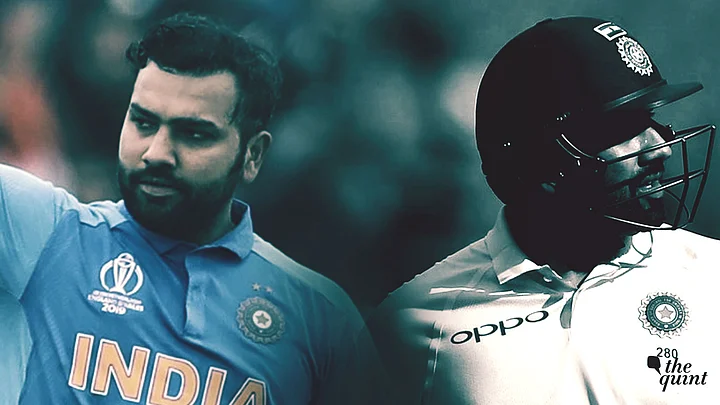With a well-crafted knock of 140 against Pakistan, Rohit Sharma is inching towards cult status. It was his second century in the 2019 World Cup and he has become the new poster boy of Indian Cricket, even eclipsing Virat Kohli for the time being.
Rohit is on a roll in the white-ball format. He has proved himself beyond any doubt in ODIs and T-20s. Just recently he led his side Mumbai Indians to their third IPL title.
But then, there is a flip side.
Even 12 years after making his international debut for India in the inaugural T-20 World Cup in 2007, Rohit Sharma has only 27 Test matches under his belt, in which he has scored 1585 runs at an ordinary average of below 40.
Don’t be in a rush to form any positive opinion on Rohit’s Test credentials. This statistic looks a little healthy essentially because of his performance at home. In 18 Test matches that he played outside India, Rohit has scored a meagre 816 runs at an abysmal average of 26.
Now this is really a curious and interesting case. What happens to such a clean striker of the ball when the colour of cloth changes from blue to white?
Let’s try to decode.
First of all Rohit is not the only one suffering from this syndrome. Consider players like Yuvraj Singh & Suresh Raina. If we dig little further, Ajay Jadeja had a similar case as well. He was an outstanding ODI batsman, cricket freaks still recall his electrifying cameo in the quarter-final match in 1996 World Cup against Pakistan, when he brought the whole Chinnaswamy Stadium on its feet. Ajay Jadeja was an indisputable part of the Indian middle order in one-day cricket for at least 6-7 years but his Test outings was almost always a disappointment.
So, is it a case of of big and natural hitters (ODI and T-20 specialists) not being able to make it big in Test matches? Well, the answer would be a resounding no.
There is a template of cricketers who were considered ODI experts initially but then they beautifully carved out Test careers. Take the case of Virender Sehwag and Kevin Peterson. In his initial days, Sehwag was like what Hardik Pandya is today – a player who could hammer the ball ferociously, coupled with handy bowling abilities. Sehwag made his Test debut much after his ODI debut. He smashed a century in very first Test and rest is history. He made his hand-eye coordination a lethal weapon.
KP was not considered to be Test-match quality initially because of his flamboyant playing style. Shane Warne, a close friend of KP, once revealed how he told English selector to take KP’s Test credentials seriously. Once given a chance in Tests, KP came out with flying colours.
So why is Rohit Sharma is not coming to terms with this format?
The reasons are somewhat subtle and the line of differentiation is thin. Few reasons can, however, be listed out. First is a player’s ability to handle short pitch bowling which plays a prominent role at big stages in Test matches (Suresh Raina understands this pain). If you can’t counter-attack a rising delivery, then at least you should be able to let it go without getting rattled.
The bigger problem, however, is to know how you react to genuine wicket-taking deliveries. The issue with Rohit is that when he is in the flow, he doesn’t change the course or reccaliberate for the occasional genuine wicket-taking delivery, and succumbs. He just gets carried away. Sunil Gavaskar once explained this by saying that a player may be enjoying his stroke play but he also needs to patiently block the odd in-swinging full-length ball and needs to just pull back when the ball is moving out after pitching at good length spot.
Restrain and discipline is the key.
At Test level, one needs to respect the bowler for what they are, capitalize on their own strengths and undermine their own weaknesses with the help of counter tactics.
During the 2003-04 tour Down Under, Sachin Tendulkar was a little shaky on deliveries outside off-stump. The master did something amazing; during his knock of 241 at Sydney, he simply did not attempt a single cover drive. In another Test in Australia, Glenn McGrath was testing Tendulkar with non-stop deliveries outside off-stump. Sachin was simply leaving them with amazing patience leading McGrath to finally give up.
Rohit needs to take a cue from here.
It would a huge loss if such a lovely striker of the ball doesn’t have a respectful Test career by the end of his time in Indian cricket. In fact in 2015 when India visited Australia, Ian Chappell tipped Rohit to be as good a Test prospect for India as Virat Kohli. With his deep understanding of the game, Ian Chappell’s words can’t be taken lightly and Rohit should not fail him.
Let’s hope that his spirited performance against Sri Lanka and his stint of captaincy would give Rohit the much-desired boost to rebuild his Test career. Just a little course correction and one good knock in trying conditions are all that Rohit needs to break the shackle.
For the times being though, let's hope he continues to enjoy this World Cup. He is going to make a real difference in this tournament and is key if India are to reach the 14 July fixture.
(The writer is an IIT graduate with a passion for sports, history and politics and can be reached at @pankajag1973)
